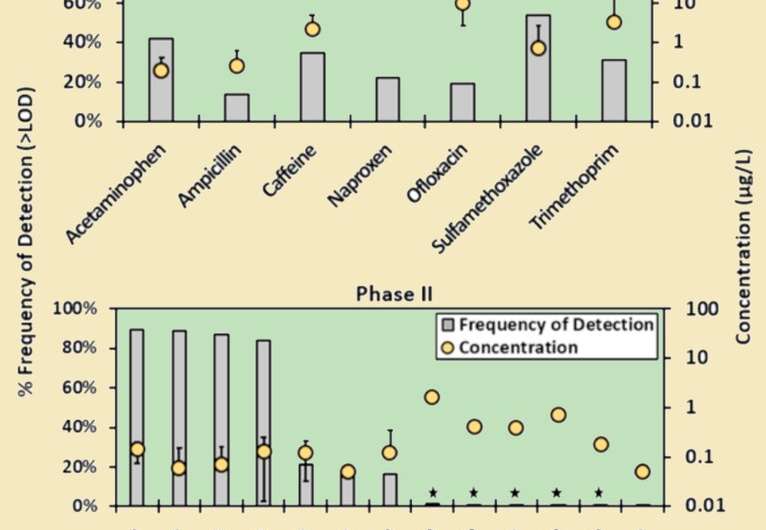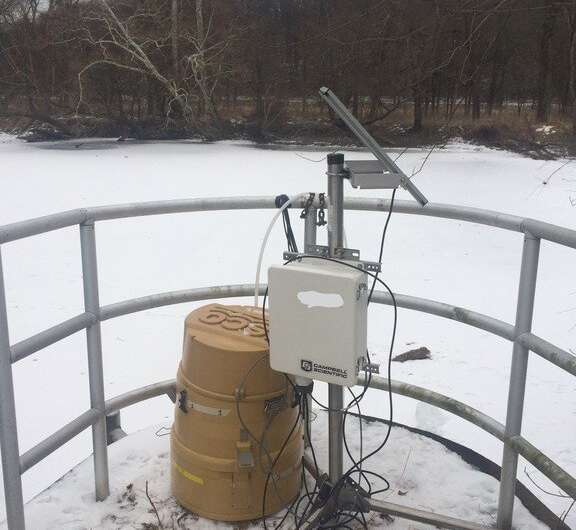Emerging organic contaminant levels greatly influenced by stream flows, seasons

Flow rates and time of year must be taken into account to better understand the potential risks posed by emerging organic contaminants in rivers and streams, according to Penn State researchers who studied contaminant concentrations and flow characteristics at six locations near drinking water intakes in the Susquehanna River basin.
While many studies have looked at the levels of emerging organic contaminants such as pharmaceuticals and pesticides in rivers and their effect on aquatic life, this is one of the first projects to closely correlate pollutant levels with flows, noted researcher Heather Preisendanz, associate professor of agricultural and biological engineering.
In addition, the research team documented seasonal changes in contaminant concentrations, with elevated levels of some contaminants seen in the warmer months, posing the greatest risk to fish during their spawning and early developmental stages, said Preisendanz. Her research group in the College of Agricultural Sciences has been studying emerging contaminants in surface water and groundwater since 2013.
Researchers worked with the Pennsylvania-American Water Co. to sample the drinking water sources of six treatment plants—three in the Susquehanna River, three in reservoirs—all in the middle section of the Susquehanna River basin in central Pennsylvania.
During the two-phase study, scientists looked for contaminants previously detected in Pennsylvania waters. In Phase I, all water samples were analyzed bimonthly for seven human pharmaceutical compounds, including four antibiotics—ampicillin, sulfamethoxazole, ofloxacin and trimethoprim; two analgesics—acetaminophen and naproxen; and a stimulant—caffeine. In Phase II, they conducted an intensive sampling regime at a single river site, focusing on a broader range of emerging organic contaminants.

In Phase I, sulfamethoxazole, acetaminophen and caffeine were most frequently detected, in 54%, 42% and 35% of the samples, respectively. Trimethoprim, naproxen, ofloxacin and ampicillin were detected in less than 35% of samples. Of the most frequently detected pharmaceuticals, caffeine had the highest average concentration, while sulfamethoxazole and acetaminophen had lower average concentrations. Ampicillin was the least frequently detected compound.
In Phase II, 13 more compounds were targeted for analysis, including human and veterinary antibiotics—chlortetracycline, tetracycline, oxytetracycline, erythromycin, sulfadiazine, sulfadimethoxine, sulfamethazine, and tylosin; an antimicrobial—triclosan; an antihistamine—cimetidine; an antidiabetic—metformin; a caffeine metabolite—theobromine; and a neonicotinoid insecticide—thiamethoxam.
In Phase II, the most frequently detected compounds were acetaminophen and theobromine—both in 89% of samples—caffeine, found in 87% of samples, and metformin in 84% of samples. Thiamethoxam, naproxen and sulfamethoxazole were detected in 21%, 17%, and 16% of samples, respectively. The other six compounds were detected in less than 2% of samples.
Concentrations of emerging organic compounds were low, but they were widespread, explained lead researcher Faith Kibuye, a doctoral candidate in the Department of Agricultural and Biological Engineering when the research was conducted.
"Overall, emerging organic contaminants were present at higher concentrations in colder seasons than warmer seasons. The concentration of thiamethoxam, a neonicotinoid insecticide, increased during high-flow periods," said Kibuye.

When flows were high, the levels of contaminants from nonpoint sources, most likely from agricultural runoff, were highest, and conversely, when flows were low, the concentrations of contaminants commonly found in sewage treatment plant discharges were highest, researchers found.
"This is because large storm events, particularly in the spring months, mobilize emerging contaminants, such as pesticides, from agricultural fields," Preisendanz said. "That explains the positive relationship between neonicotinoid concentrations and flow rate."
The picture was less clear for the contaminants that have both point and nonpoint sources, Preisendanz added, because some older municipalities have combined storm and sanitary sewer systems that discharge untreated sewage during high-flow events.
Even without water quality standards to define what levels might be considered safe for various aquatic organisms and human health, the researchers calculated risk assessments for compounds found in the study using exposure limits already set by the U.S. Food and Drug Administration. Those calculations revealed that although the compounds posed medium to high risk to aquatic organisms, human health risk from drinking water or consuming fish is low. However, the study's findings, recently published in Chemosphere, did not determine the risks due to the presence of multiple contaminants in the water simultaneously.
"We do not know the effect of being exposed to a cocktail of these compounds, even at low levels, and whether they might have a synergistic effect," Preisendanz said.
More information: Faith A. Kibuye et al, Influence of hydrologic and anthropogenic drivers on emerging organic contaminants in drinking water sources in the Susquehanna River Basin, Chemosphere (2019). DOI: 10.1016/j.chemosphere.2019.125583
Journal information: Chemosphere
Provided by Pennsylvania State University





















